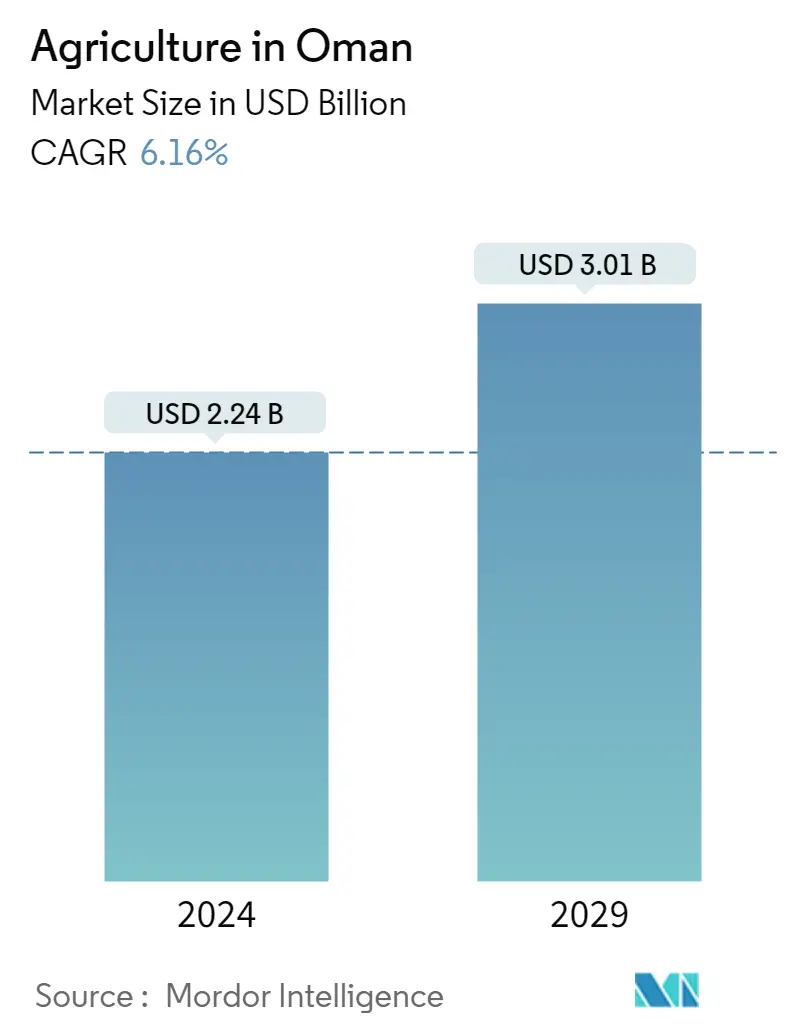Market Size of Agriculture in Oman

| Study Period | 2018 - 2028 |
| Base Year For Estimation | 2021 |
| Forecast Data Period | 2023 - 2028 |
| Market Size (2023) | USD 2.11 Billion |
| Market Size (2028) | USD 2.84 Billion |
| CAGR (2023 - 2028) | 6.16 % |
Need a report that reflects how COVID-19 has impacted this market and its growth?
Oman Agriculture Market Analysis
The Agriculture Market in Oman is estimated at USD 2.11 billion in 2023, and is expected to reach USD 2.84 billion by 2028, growing at a CAGR of 6.16% during the forecast period (2023-2028).
- The increase in the adoption of advanced farming technologies and conducive government policies supporting domestic crop production are some factors driving the country's market growth. Through imports, Oman meets its domestic fruits, vegetables, and cereals demand. Therefore, to reduce import dependency, the country aims for self-sufficiency in agricultural products by encouraging its farmers to adopt advanced farming techniques.
- Agricultural production in Oman consists mainly of dates, vegetables, and fruits, while other crops are cultivated at lesser volumes. According to world bank statistics, the total amount of agricultural land in Oman was about 1.4 million hectares in 2020, which accounted for 4.7% of the total land area. Fruits like bananas and papaya are also grown in coastal regions, which accounted for 18,447 ton and 5,840 ton of production, respectively, in 2020. Additionally, Oman increased its barley, sorghum, and wheat production in recent years.
- Moreover, the government launched several initiatives to encourage private sector production, such as updating regulations, providing low-interest loans, aiding domestic production, and running campaigns to increase the visibility of locally made products, which is expected to boost the growth of agriculture in Oman during the forecast period.
Oman Agriculture Industry Segmentation
Oman is recognized for its rich agricultural diversity involving almost all crop species. The Oman agriculture market report is segmented by type (cereals, oilseeds, fruits, and vegetables). The report includes production analysis (volume), consumption analysis (value and volume), export analysis (value and volume), import analysis (value and volume), and price trend analysis. The report offers market size and forecasts regarding value (USD million) and volume (ton) for all the above segments.
| Crop Type (Production Analysis by Volume, Consumption Analysis by Value and Volume, Import Analysis by Value and Volume, Export Analysis by Value and Volume, and Price Trend Analysis) | |
| Cereals | |
| Oilseeds | |
| Fruits | |
| Vegetables |
Agriculture in Oman Size Summary
The agriculture market in Oman is witnessing significant growth, driven by the adoption of advanced farming technologies and government policies supporting domestic crop production. The nation aims to achieve self-sufficiency in agricultural products to reduce import dependency, hence encouraging farmers to adopt innovative farming techniques. Agricultural production primarily includes dates, vegetables, and fruits, with other crops cultivated on a smaller scale. The government has launched initiatives to encourage private sector production, such as updating regulations, providing low-interest loans, aiding domestic production, and running campaigns to increase the visibility of locally made products. Government policies are propelling market expansion by promoting the adoption of cutting-edge farming technologies and reducing import dependency. Various incentives are offered to attract more agricultural investments. The agricultural ministry offers monetary and synthetic loans to install modern irrigation systems, exempting businesses from income tax on agricultural output projects. The well-established retail networks are also supporting the growth of agriculture in the country. The retail industry, characterized by strong consumer demand, robust economic growth, distinct demographic factors, and high-end technology system, ensures better customer service and efficient customer checks. The increasing presence of major retailers and supermarkets and their aggressive import strategies result in better access to many fruits and vegetables for the Omani population at comparatively cheaper rates.
Explore MoreAgriculture in Oman Market Size - Table of Contents
-
1. MARKET DYNAMICS
-
1.1 Market Overview
-
1.2 Market Drivers
-
1.3 Market Restraints
-
-
2. MARKET SEGMENTATION
-
2.1 Crop Type (Production Analysis by Volume, Consumption Analysis by Value and Volume, Import Analysis by Value and Volume, Export Analysis by Value and Volume, and Price Trend Analysis)
-
2.1.1 Cereals
-
2.1.2 Oilseeds
-
2.1.3 Fruits
-
2.1.4 Vegetables
-
-
Agriculture in Oman Market Size FAQs
How big is the Agriculture in Oman Market?
The Agriculture in Oman Market size is expected to reach USD 2.11 billion in 2023 and grow at a CAGR of 6.16% to reach USD 2.84 billion by 2028.
What is the current Agriculture in Oman Market size?
In 2023, the Agriculture in Oman Market size is expected to reach USD 2.11 billion.
